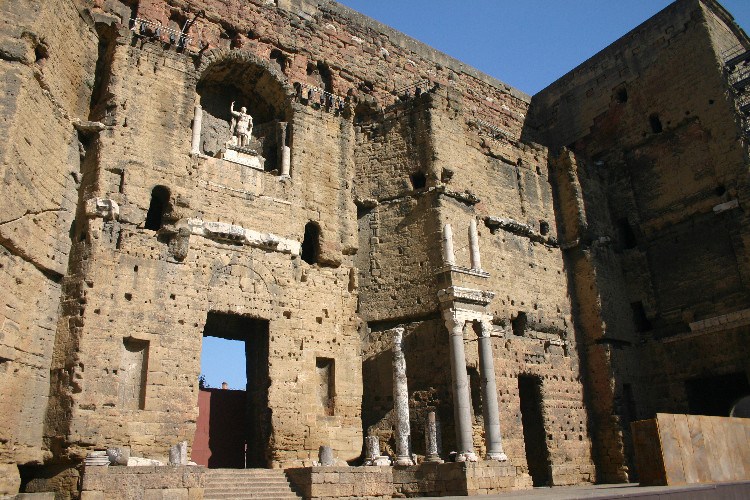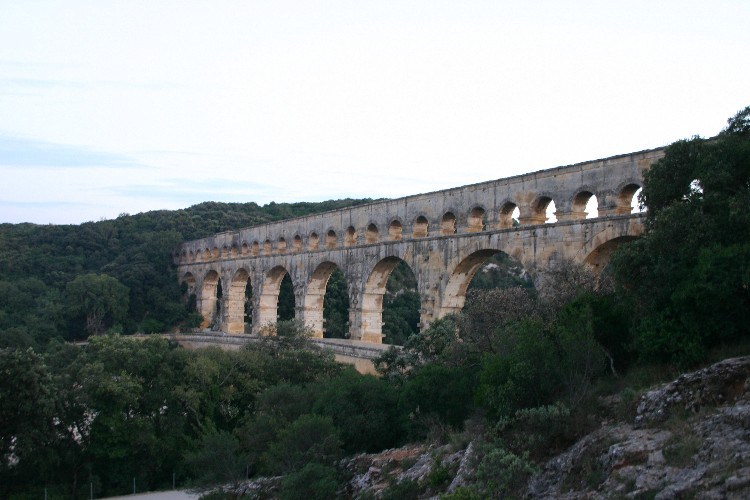Traffic on the A9 is light as we head out to Orange,
home of the family that includes St. Guilhem, the Dutch royal family, and William of Orange, the King of England. Orange is also home to the only Roman Amphitheater in Europe with its stage wall intact.
Harvest at Chateauneuf-du-Pape
From Orange, we drive the 8 kilometres to Chateauneuf-du-Pape, home of one of the world’s premier wines. Harvest is in full swing as we drive along the country roads, the air is pungent with the smell of grapes. As we get into town, we see that many of the caves are closed, and have signs directing inquiries to the vineyards themselves. We climb up above the city to the remains of the palace that the popes built for themselves when the papacy was in Avignon. There is a magnificent view of the Rhone from up here. On the walk down into town, Rose spots a restaurant she has read about in her restaurant guide, La Mere Germaine, and we decide that it is just the place for lunch. We sit on a terrace, protected from the heat of the sun but with a view over the vineyards, and we have a wonderful meal. As is quickly becoming the norm, we order the “Menu”; our desserts are truly amazing!
Avignon: the famous bridge and the Palais des Papes.
The papacy resided in Avignon for close to 100 years in the 1300s; although the information given at the Palais des Papes itself treads lightly on the history, we come to understand that the Pope was forced to move here by the French-born King of Naples, “for his own protection”. The Avignon papacy, of course, ended with the schism that saw 2 cardinals both claiming to be Pope. The palace built by the Popes whilst in Avignon is enormous and hugely impressive. We are fascinated that the tour itself starts in the Treasury, where the Pope’s right-hand man counted the money coming in from the sale of indulgences. Following the Revolution, the Palais des Papes was for many years a military barracks, until Napoleon III visited and recognized its historic importance, and ordered the military to vacate. Much of the original décor was destroyed during this time, but we see glimpses of the former splendour, particularly on a tile floor that is original in the Pope’s study.
We spend a long time at the Palais, fascinated by the history and the building itself. When finally we leave, we head to the Pont Saint-Benezet, the famous Pont d’Avignon where everybody dances. The first bridge over the Rhone south of Lyon, it was opened in 1185. Today the Rhone is calm, thanks to many dams that control its flow. It once was anything but, and the bridge meant that Avignon became an important town for both trading and pilgrims heading to Santiago de Campostello.
Le Pont du Gard at Sunset
From Avignon, we head back towards home, but we are not yet done for the day. As we cross back into Languedoc from Provence, we see signs for the Pont du Gard and realize that it will take us only 6 kilometres out of our way to see this feat of Roman engineering. And so off we go. The Pont du Gard is a 275 metre long, 3 tiered aqueduct that is part of a 50-kilometre long system of canals built by Agrippa in 19 BC to bring water to Nimes. Engineered to carry 20,000 cubic metres of water per day, and even during Roman times, the Pont was known as an engineering masterpiece. Today it is a UNESCO World Heritage Site.
By the time we get home, we are ready for bed. Supper, such as it is, consists of cheese and crackers – without question, French cheese and French crackers, with a nice bottle of red wine from the vineyard down the road from the house.













Comments